第十二章价格策略
第12章 价格策略
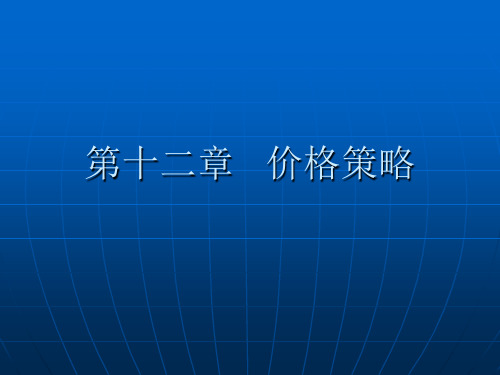
塘里无鱼虾子贵
陶朱公范蠡从越国激流勇退之后,先开了一个卖古玩字画的店铺。有一次, 一位江西富商来到店里,看中了一套三件式精美细致的古砚,售价800两。富 商十分喜欢这套东西,但是却认为价格太高,于是推说只看中了其中两件, 要范蠡降价。范蠢看了看他,要价800两。 富商仍然嫌贵,不愿掏钱。这时范蠡慢慢悠悠地开口说:“这样看来,你 是没有看中我这套东西。既然这样,我怎么好意思再卖给别人呢?” 说着,他随手拿起一件丢在了地上,精致的古砚马上摔得粉碎。 富商见自己喜爱的古砚被摔碎了,心中十分痛惜,再也没法矜持下去,急 忙阻拦陶朱公,问剩下的两件卖多少钱?陶来公伸手比了一下:800两。 富商觉得太离谱了,要求再降价。范蠢并不答话,又把另一件古砚摔在地 上。富商问剩下的最后一件卖多少钱。范蠡面色不变:800两。富商有些生气 地说:“难道一件和三件的价钱一样吗?” 范蠡想了想,微然一笑说道:“是不应该一个价钱,我这一件卖1000 两。” 富商还在犹豫,范蠡又把最后一件古砚拿在手里,作势要摔。富商再也沉 不住气了,请求范蠡不要再毁,他愿意出1000两把这套残缺不全的古砚买走。 交易完成以后,看得目瞪口呆兼佩服得五体投地的小伙计问范蠡:“为什 么摔掉了两件,反而卖了1000两银子?” 范蠡回答说:“物以稀为贵。富商喜欢收藏古砚,只要他喜欢上的东西, 他是绝不会轻易放掉的。我摔掉两件,留下的一件当然价钱就更高了。”
折扣定价策略
这是根据不同情况,减少一部分定价。通常 有以下几种: 1、数量折扣。为刺激顾客大量购买,或集中 向一家购买,根据购买的数量或金额,企业 给予其一定的折扣。顾客所购买的数量越多, 金额越大,折扣也就越大。 2、现金折扣。为鼓励顾客提前偿付货款,对 提前付款的顾客给予一定的折扣。 3、季节折扣。励中间商提早储存产品,对淡 季来采购的顾客给予折价优惠。 4、业务折扣 。
2016市场营销学(高教第3版)教案:第十二章价格策略
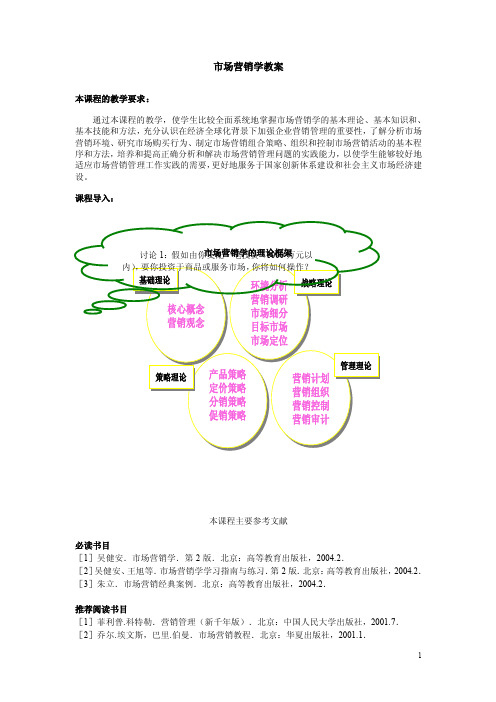
市场营销学教案本课程的教学要求:通过本课程的教学,使学生比较全面系统地掌握市场营销学的基本理论、基本知识和、基本技能和方法,充分认识在经济全球化背景下加强企业营销管理的重要性,了解分析市场营销环境、研究市场购买行为、制定市场营销组合策略、组织和控制市场营销活动的基本程序和方法,培养和提高正确分析和解决市场营销管理问题的实践能力,以使学生能够较好地适应市场营销管理工作实践的需要,更好地服务于国家创新体系建设和社会主义市场经济建设。
课程导入:本课程主要参考文献必读书目[1]吴健安.市场营销学.第2版.北京:高等教育出版社,2004.2.[2]吴健安、王旭等.市场营销学学习指南与练习.第2版.北京:高等教育出版社,2004.2.[3]朱立.市场营销经典案例.北京:高等教育出版社,2004.2.推荐阅读书目[1]菲利普.科特勒.营销管理(新千年版).北京:中国人民大学出版社,2001.7.[2]乔尔.埃文斯,巴里.伯曼.市场营销教程.北京:华夏出版社,2001.1.[3]吴晓云.工商管理市场营销案例精选.天津:天津大学出版社,2001.3.[4]Philip Kotler.Marketing Management.北京:清华大学出版社,1997.3.[5]Philip Kotler &Gary Armstrong.Principles of Marketing.北京:清华大学出版社,1997.10.选读书目[1]本.恩尼斯等.营销学经典.郑琦等译.大连:东北财经大学出版社,2000.11.[2]郭国庆等.市场营销理论.北京:中国人民大学出版社,1999.10.[3]迈克尔.波特.竞争战略.陈小悦译.北京:华夏出版社,1997.1.[4]彼得.德鲁克.管理实践.中译本.上海:上海译文出版社,1999.期刊[1]销售与市场.河南郑州.[2]成功营销.北京.[3]市场营销.北京.[4]市场营销文摘卡.北京.[5]中国流通经济.北京.[6]商业研究.哈尔滨.[7]市场营销导刊.北京.[8]管理世界.北京.[9]商业时代(理论版).北京.网站[1]中国营销传播网.第十二章价格策略知识回顾:詹姆士·诺特说:定价是一种微妙的艺术,其成分构成扑朔迷离,俗称“黑三角”即:1/3的事实;1/3的猜测;1/3的经济理论。
吴健安《市场营销学》笔记和课后习题详解(第十章 产品策略——第十二章 定价策略)【圣才出品】

第十章产品策略10.1 复习笔记一、产品整体概念1.产品及产品整体概念产品是指能够通过交换满足消费者或用户某一需求和欲望的任何有形物品和无形的服务。
关于产品整体概念,按以下五个层次来表述产品整体概念:(1)核心产品核心产品是指向顾客提供的基本效用或利益,从根本上说,每一种产品实质上都是为解决问题而提供的服务。
营销人员向顾客销售的任何产品,都必须具有反映顾客核心需求的基本效用或利益。
(2)形式产品形式产品是指产品的基本形式,或核心产品借以实现的形式,或目标市场对某一需求的特定满足形式。
形式产品由五个特征所构成,即品质、式样、特征、品牌及包装。
市场营销人员应努力寻求更加完善的外在形式以满足顾客的需要。
(3)期望产品期望产品是指购买者在购买该产品时,期望得到的与产品密切相关的一整套属性和条件。
(4)延伸产品延伸产品是指顾客购买形式产品和期望产品时,附带获得的各种利益的总和,包括产品说明书、保证、安装、维修、送货、技术培训等。
能够正确发展延伸产品的公司,必将在竞争中赢得主动权。
(5)潜在产品潜在产品是指现有产品包括所有附加产品在内的,可能发展成为未来最终产品的潜在状态的产品,指出了现有产品的可能演变趋势和前景。
产品整体概念的五个层次,清晰地体现了以顾客为中心的现代营销观念,如图10-1所示。
图10-1 整体产品概念的五个层次2.产品的分类(1)非耐用品、耐用品和服务①非耐用品。
指有一种或多种消费用途的低值易耗品;②耐用品。
指使用年限较长、价值较高的有形产品,通常有多种用途;③服务。
指为出售而提供的活动、利益或满足。
劳务的特点是无形、不可分、易变和不可储存。
(2)消费品分类消费品是指由最终消费者购买并用于个人消费的产品。
根据消费的特点可以区分为便利品、选购品、特殊品和非渴求物品4种类型。
①便利品。
指顾客频繁购买或需要随时购买的产品。
便利品可以进一步分成常用品、冲动品以及救急品。
②选购品。
指顾客在选购过程中,对适用性、质量、价格和式样等基本方面要做认真权衡比较的产品。
第十二章 定价策略

市 场 营 销 精 品 课 程 课 件
根据成本加成公式,则: 根据成本加成公式, 商品的单价=单位总成本×(1+目标利润率) 商品的单价=单位总成本× 目标利润率) =(总成本十总成本×目标利润率)÷预计销量 总成本十总成本× =(总成本十总成本 目标利润率) =(总成本十目标收益)÷预计销量 =(总成本十目标收益) 总成本十目标收益 企业是通过预计销量来确定价格,但是价格本身恰恰是 影响销售量的主要原因,也就是说在价格是未知的情况下, 做出的销量预计具有很大的不确定性,而在不准确的销量预 测基础上制定的价格,往往是不科学的。
收 入 / 成 本
总收入 市 场 营 销 精 品 课 程 课 件 TC
FC
平衡点产量
产量
利润=总收入-(固定成本+变动成本) 利润=总收入-(固定成本+变动成本) -(固定成本 -(FC VC× FC+ ∏ =P× Q-(FC+VC×Q) +1.8× 000) ∏ =3× 100 000 - (60 000 +1.8× 100 000) 000元 =60 000元
市 场 营 销 精 品 课 程 课 件
二、需求导向定价法
㈠认知价值定价法 认知价值定价法是指根据消费者对企业提供的商品 价值的主观评判来制定价格的方法。通俗的说,也就是 企业提供的商品在消费者心目中值多少钱。
市 场 营 销 精 品 课 程 课 件
六、法律及政策限制
国家法律和政策对价格的影响,往往至关重要。政府 和立法部门往往从全局出发,为了维护国家、社会和消费 者的利益,制定了一系列的经济法规,来约束和规范企业 的价格行为。
市 场 营 销 精 品 课 程 课 件
例如: 例如:
中国政府为了保护消费者的利益不受到侵害,设立了专门 的物价机构来审查企业产品的定价是否合理,特别是对一 些关系到国计民生的重要产品的价格(如汽油价格、铁路 运输费、水费、电费等)制定了最高上限,而且近年来还 特别举行了专门的听证会来确定这些产品价格调整的合理 性;
价格策略综合概述

04
价格策略的实施与监控
实施价格策略的途径与手段
基于成本
根据产品的成本、利润和市场份额来制定价格策 略。
市场导向
根据市场需求、竞争状况和消费者心理来制定价 格策略。
促销导向
通过打折、促销和赠品等方式来吸引消费者,提 高销售额。
监控价格策略的效果
销售数据
通过分析销售数据来了解价格策略是否有效,是否达到预期的 销售目标。
成本加成价格策略
在产品成本上加上一定的利润,以确定产品的 售价。
边际成本价格策略
3
根据产品的边际成本定价,以实现利润最大化 。
基于竞争的价格策略
市场渗透价格策略
通过降低产品价格来增加市场 份额,从而扩大品牌影响力。
市场竞争价格策略
根据市场竞争状况调整价格,以 实现销售目标。
差别化价格策略
针对不同市场和客户群体制定不同 的价格,以获取最大利润。
估算成本和需求量
成本估算
准确估算企业的生产成本、采购成本、运营成本等,为制定价格策略提供依据。
需求量预测
根据市场需求和竞争状况,预测市场需求量,为制定价格策略提供依据。
选择合适的价格策略
01
成本导向
以成本为定价基础,制定价格策略时考虑成本、利润和争对手为定价基础,制定价格策略时考虑竞争对手的定价、市场
价格策略的未来发展趋势
影响未来价格策略的因素
01
02
03
技术进步
人工智能、大数据等新技 术将提高价格策略的精准 度和效率。
全球化
全球市场竞争将更加激烈 ,价格策略需要更加灵活 、精细。
消费者需求
消费者对价格的敏感度不 断提高,价格策略需满足 消费者需求。
营销管理-第十二章-价格策略
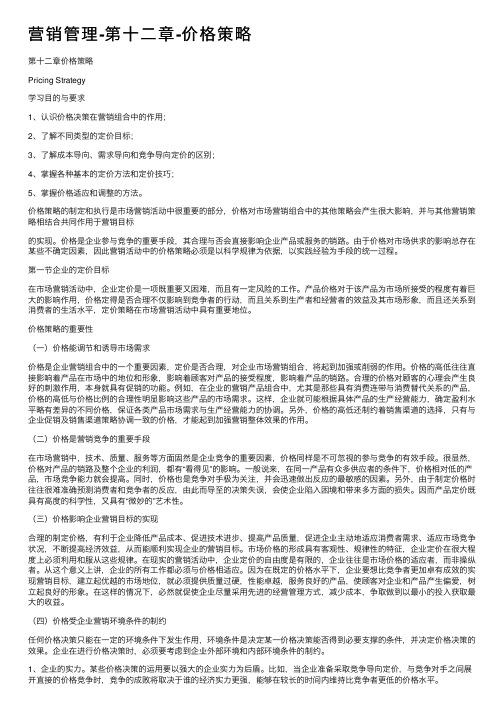
营销管理-第⼗⼆章-价格策略第⼗⼆章价格策略Pricing Strategy学习⽬的与要求1、认识价格决策在营销组合中的作⽤;2、了解不同类型的定价⽬标;3、了解成本导向、需求导向和竞争导向定价的区别;4、掌握各种基本的定价⽅法和定价技巧;5、掌握价格适应和调整的⽅法。
价格策略的制定和执⾏是市场营销活动中很重要的部分,价格对市场营销组合中的其他策略会产⽣很⼤影响,并与其他营销策略相结合共同作⽤于营销⽬标的实现。
价格是企业参与竞争的重要⼿段,其合理与否会直接影响企业产品或服务的销路。
由于价格对市场供求的影响总存在某些不确定因素,因此营销活动中的价格策略必须是以科学规律为依据,以实践经验为⼿段的统⼀过程。
第⼀节企业的定价⽬标在市场营销活动中,企业定价是⼀项既重要⼜困难,⽽且有⼀定风险的⼯作。
产品价格对于该产品为市场所接受的程度有着巨⼤的影响作⽤,价格定得是否合理不仅影响到竞争者的⾏动,⽽且关系到⽣产者和经营者的效益及其市场形象,⽽且还关系到消费者的⽣活⽔平,定价策略在市场营销活动中具有重要地位。
价格策略的重要性(⼀)价格能调节和诱导市场需求价格是企业营销组合中的⼀个重要因素,定价是否合理,对企业市场营销组合,将起到加强或削弱的作⽤。
价格的⾼低往往直接影响着产品在市场中的地位和形象,影响着顾客对产品的接受程度,影响着产品的销路。
合理的价格对顾客的⼼理会产⽣良好的刺激作⽤,本⾝就具有促销的功能。
例如,在企业的营销产品组合中,尤其是那些具有消费连带与消费替代关系的产品,价格的⾼低与价格⽐例的合理性明显影响这些产品的市场需求。
这样,企业就可能根据具体产品的⽣产经营能⼒,确定盈利⽔平略有差异的不同价格,保证各类产品市场需求与⽣产经营能⼒的协调。
另外,价格的⾼低还制约着销售渠道的选择,只有与企业促销及销售渠道策略协调⼀致的价格,才能起到加强营销整体效果的作⽤。
(⼆)价格是营销竞争的重要⼿段在市场营销中,技术、质量、服务等⽅⾯固然是企业竞争的重要因素,价格同样是不可忽视的参与竞争的有效⼿段。
医药产品价格策略
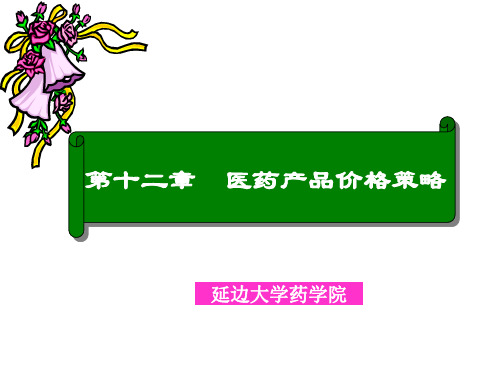
第三节:企业定价目标与程序
定价目标1-----公司方面
是利润
各位同仁, 你们认为我们公司
的定价目标是什么?
我认为是生存
是销售增长
是质量和服务
定价目标2-----竞争对手方面
各位同仁, 针对竞争对手,我们的 定价目标是什么?
与他们打价格战
我认为是让他们 俯首称臣
设置壁垒, 不让其它人进来
把竞争者赶出去
老板,A公司 的定价是20元
四、竞争导向定价法
• 4、招标和拍卖定价法。
B 公司是25元
我们招标 或拍卖
老板,A公司 的定价是20元
第五节:企业定价策略
一、新产品的定价策略
• 1、撇油定价策略(高价策略)。新产品在试 生产阶段,成本很高,企业相应制定的试制价 格也很高。
• 优点:(1)尽快收回新产品投资,并在短期内 获取收益。(2)以高价树立优质产品的形象。 (3)为今后的降价创造条件。
• 根据公式Z=Q×(P—Cv)一F得:
•
Z1=30 000×(25—22)一160 000=70000(元)
•
Z2=20 000×(30—22)一160 000=0(元)
•
Z3=18 000×(35—22)一160 000=74000(元)
•
Z4=10 000×(40—22)一160 000=2000(元)
• 故应定价35元,收益最大。
四、竞争导向定价法
• 1、随行就市定价法。
• 这是根据本行业平均定价水平作为本企业定价 标准的一种定价方法。
B 公司是25元
我们就 订23元吧
老板,A公司 的定价是20元
四、竞争导向定价法
• 2、低于竞争者产品价格定价。
第十二章 定价策略
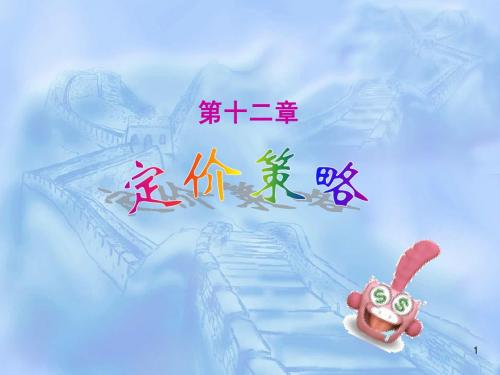
第一节 一、定价目标
影响定价的因素
6
定价目标(1) ——公司方面的
各位同仁, 你们认为我们公司 的定价目标是什么? 是利润
是销售增长 我认为是生存 是质量和服务
7
定价目标(2) ——竞争对手方面的
各位同仁, 针对竞争对手,我们的 定价目标是什么? 与他们打价格战 我认为是让他们 俯首称臣
设置壁垒, 不让其它人进来
33
(一)密封投标定价法
工程投标
10万元
10.5万元
9.9万元
11万元
34
(二)随行就市定价法
就是指按照行业的平均现行价格水平定价。 应用条件: (1)难以估算成本。 (2)企业打算与同行和平共处。 (3)如果另行定价,很难了解购买者和 竞争者对本企业价格的反应。
35
第三节
定价的基本策略
一、折扣定价策略 二、地区定价策略 三、心理定价策略 四、差别定价策略 五、新产品定价策略 六、产品组合定价策略
25
(三)变动成本定价法
单位边际贡献=单价-单位变动成本 此方法重点是在考虑变动成本的回收后 尽量补偿固定成本。
厂里没活干, 员工人心不稳, 谣言四起。 干! 不干更亏
老板,A公司的出价 很低,我们根本赚不 到钱!
26
二、需求导向定价法 需求导向定价法就是以需求为中 心的定价方法。如认知价值定价 法、反向定价法、需求差别定价法等。
56
3、产品地点差别定价
地点差异
2009中超联赛
江苏舜天/山东鲁能
特区:160元 甲区:120元 乙区:40元 丙区:20元
57
4、销售时间差别定价
时间差异 某保龄球馆
上午:5元/局
第十二章价格策略
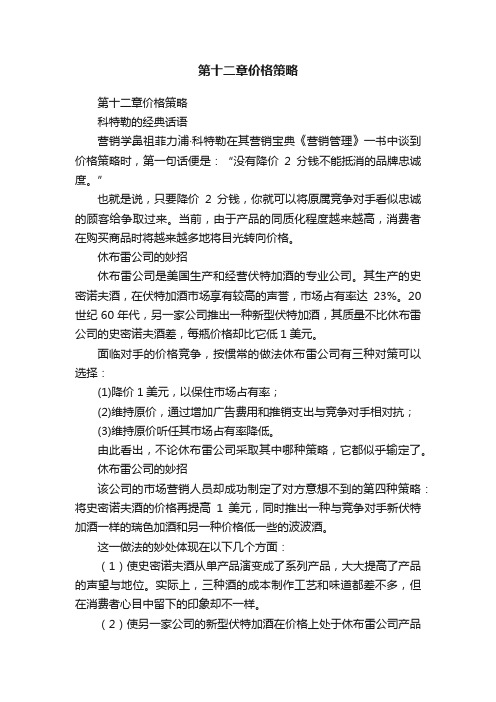
第十二章价格策略第十二章价格策略科特勒的经典话语营销学鼻祖菲力浦·科特勒在其营销宝典《营销管理》一书中谈到价格策略时,第一句话便是:“没有降价2分钱不能抵消的品牌忠诚度。
”也就是说,只要降价2分钱,你就可以将原属竞争对手看似忠诚的顾客给争取过来。
当前,由于产品的同质化程度越来越高,消费者在购买商品时将越来越多地将目光转向价格。
休布雷公司的妙招休布雷公司是美国生产和经营伏特加酒的专业公司。
其生产的史密诺夫酒,在伏特加酒市场享有较高的声誉,市场占有率达23%。
20世纪60年代,另一家公司推出一种新型伏特加酒,其质量不比休布雷公司的史密诺夫酒差,每瓶价格却比它低1美元。
面临对手的价格竞争,按惯常的做法休布雷公司有三种对策可以选择:(1)降价1美元,以保住市场占有率;(2)维持原价,通过增加广告费用和推销支出与竞争对手相对抗;(3)维持原价听任其市场占有率降低。
由此看出,不论休布雷公司采取其中哪种策略,它都似乎输定了。
休布雷公司的妙招该公司的市场营销人员却成功制定了对方意想不到的第四种策略:将史密诺夫酒的价格再提高1美元,同时推出一种与竞争对手新伏特加酒一样的瑞色加酒和另一种价格低一些的波波酒。
这一做法的妙处体现在以下几个方面:(1)使史密诺夫酒从单产品演变成了系列产品,大大提高了产品的声望与地位。
实际上,三种酒的成本制作工艺和味道都差不多,但在消费者心目中留下的印象却不一样。
(2)使另一家公司的新型伏特加酒在价格上处于休布雷公司产品的“夹击”之中,消费者想不同的伏特加酒,都有可能选购休布雷公司的产品。
(3)从无差异目标市场策略转向了差异性目标市场策略,为占领广泛市场奠定了坚实的基础。
本章纲要第一节影响定价的因素一、定价目标二、产品成本产品成本是理论上的价格底限低廉的飞机票价2005年春运前热点航线的票价比火车票还便宜,其中北京至上海普通的单程机票最低价格为260元,北京至广州最低430元。
而北京至上海T103次的硬卧下铺价格为327元,北京至广州的T29次硬卧下铺价格为458元。
第12章 价格策略课件
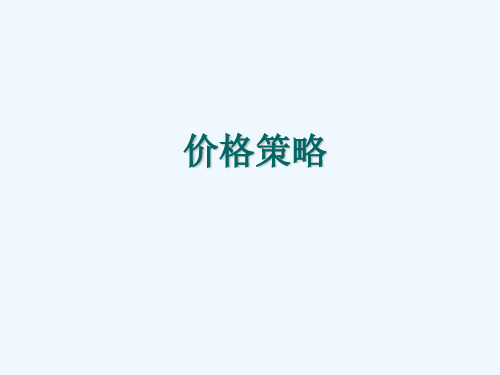
成本是定价的下限, 成本可分为两种类 型:固定成本和可 变成本。
又称间接成本,指 不随产量的变化而变 化的成本。
又称直接成本。指随 产量的变动而变化的
成本。
总成本=固定成本+可变成本
(三)需求价格弹性
产品的最高价格取决于产品的市场 需求,最低价格取决于产品的成本。
需求又受价格和收入变动的影响。
1 价格与供需关系
价格策略
• 价格是真理的时刻——定价是所有营销活 动的焦点。
——雷蒙德﹒科里
前言
• 价格是营销中最活跃的因子,它一向是影响顾客 选择的最主要因素之一,是市场营销组合策略 (4Ps)中一个十分敏感的因素,它直接关系到 市场需求量的多少和企业赢利的高低,并影响着 营销组合的其它因素。
• 企业在处理定价方面常出现的误区有:
2、市场占有率导向目标
市场占有率是公司经营状况和公司产品在市场上的竞争能 力的直接反映,对于公司的生存和发展具有重要意义。所以, 有时公司把保持或扩大市场占有率看得非常重要。
因为,市场占有率一般比最大利润容易测定,也更能体现 公司努力的方向。
一般来讲,只有当公司至少处于以下几种情况之一时,才 适合采用该种定价目标 。
是以成本为依据的定价方法,主要有: • 1. 加成定价法
– 完全成本加成定价法 – 进价加成定价
• 优点:计算简便,体现了以产品价值为基础来定 价的原理。采用这种方法确定的价格,可以保证 获得正常的利润率,从而能够保障生产经营的正 常进行。
• 缺点:在于不能反映市场需求状况和竞争状况。
–完全成本加成定价法(水果商店) 价格=单位完全成本(1+成本加成率)
• 市场若存在领导者价格,则以此价格作为 参照,以相同或低于领导者的价格谋求市 场发展
培训课件价格策略

培训课件价格策略contents •培训课件价格策略概述•培训课件定价策略分析•培训课件价格策略的制定•培训课件价格策略的调整与优化•培训课件价格策略的案例分析目录01培训课件价格策略概述定义重要性定义与重要性价格策略的制定过程执行价格策略,并根据市场反馈和竞争态势进行适时调整。
基于市场需求、竞争状况和成本分析,制定相应的价格策略。
准确核算制作和销售培训课件的成本,包括人力、材料、运营等费用。
通过市场调研,了解客户对培训课件的价格敏感度和期望。
了解竞争对手的课件价格、质量和服务,以制定具有竞争力的价格策略。
价格策略的竞争优势03020102培训课件定价策略分析固定成本考虑随着销售量的增加,单位产品的成本会降低,因此在定价时需要考虑这一点。
变动成本利润率产品特点根据培训课件的特点和优势来定价,例如针对某个领域的专业培训课件,由于其专业性和稀缺性,可以制定较高的价格。
客户需求根据客户对培训课件的期望和需求程度来定价,例如客户对培训效果期望较高,可以制定相对较高的价格。
附加价值除了产品本身的价值外,还可以提供额外的服务或福利来增加产品的附加值,例如提供在线辅导、答疑等服务。
基于价值定价策略价格策略选择的考虑因素市场环境产品特点企业战略目标03培训课件价格策略的制定目标市场定位确定目标市场与定位竞争对手了解同行业的竞争对手,如其他培训机构、在线教育平台等。
定价策略分析竞争对手的定价策略,如价格高低、折扣力度等,以了解市场行情。
分析竞争对手的定价策略确定价格策略与定位价格策略根据目标市场的需求、竞争对手的定价策略以及自身的定位,制定相应的价格策略,如高价策略、低价策略、成本加成等。
定位根据价格策略,进一步明确培训课件的定位,如高品质、高性价比等。
价格策略的执行与监控执行监控04培训课件价格策略的调整与优化销售额与利润市场占有率客户满意度价格策略的绩效评估03产品定位变化价格策略的调整时机与方式01市场需求变化02竞争状况变化优化价格策略的方法与技巧根据不同客户群体、不同销售渠道、不同地区等因素制定差异化的价格策略,以满足不同需求。
第12章 价格策略PPT课件
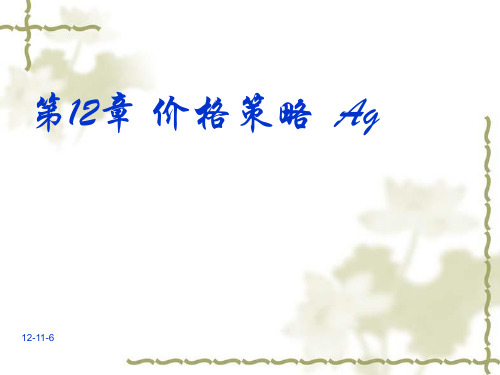
12-11-6
第12章 价格策略
12.1 价格及其影响因素 12.2 企业的定价方法 12.3 定价策略 12.4 调价策略
12-11-6
引导案例新世纪影城腾飞的动力——别出
❖ 2.外部因素 ❖ ⑴ 市场需求 ❖ ⑵ 政治环境 ❖ ⑶ 竞争者
12-11-6
12.2 企业的定价方法
❖ 12.2.1 成本导向定价法
❖ 1. 成本加成定价法
❖ (1)外加法
❖
产品价格 =
❖ (完全成本+完全成本x成本利润率)/(1-税 率)
❖ (2)内扣法
1❖2-11-6 产品价格 = 完全成本 / (1-销价利润
❖ ①利润最大化 ❖ ②市场占有率最大化 ❖ ③维持生存 ❖ ④质量最优化
12-11-6
⑵ 营销组合战略 ⑶ 产品成本 ❖ ①固定成本 ❖ ②变动成本 ❖ ③边际成本 ❖ ④机会成本
12-11-6
⑷ 产品差异性 所谓产品差异性是指产品具有独特的个性,拥 有竞争者不具备的特殊优点,从而与竞争者形 成差异。产品差异性不仅指实体本身,而且包 括产品设计、商标品牌、款式和销售服务方式
12-11之-6 处:“可以在水中写字,也可以在高海拔
❖ 这些都是朵儿顿根据圆珠笔的特性和美国人 追求新奇的性格精心制定的促销策略。果然, 公司主管对此深感兴趣,一下子订购了2500 支,并采用朵儿顿的促销口号为广告。当时 这种圆珠笔的生产成本仅为0.8美元,但朵儿 顿果断的将售价抬高到20美元。因为只有这 个价格才能让人们觉得这只笔与众不同,配 得上“原子笔”。
定价策略-第十二章

二、定价的基本策略(续)
(五)新产品定价策略 1 、撇脂定价 所谓撇脂定价,是指在产品生命周期的最初阶段, 把产品的价格定得很高,以攫取最大利润,犹如从鲜奶 中撇取奶油。 采取撇脂定价的条件: 1 )市场有足够的购买者,他们的需求缺乏弹性, 即使把价格定得很高,市场需求也不会大量减少。 2 )高价使需求减少一些,因而产量减少一些,单 位成本增加一些,但这不致抵消高价所带来的利益· 。 3 )在高价情况下,仍然独家经营,别无竞争者。 4 )某种产品的价格订得很高,使人们产生这种产 品是高档产品的印象。
一、影响定价的因素(续)
(二)产品成本 企业对价格的承受程度,就是企业所能定出 的最低价格。 (三)市场需求 (四)竞争者的产品和价格
一、影响定价的因素 --案例 1
在比利时的一间画廊里,一位美国画商正和一位印 度画家在讨价还价,争辩得很激烈其实,印度画家的每幅 画底价仅在 10-100 美元之间。但当印度画家看出美国画 商购画心切时,对其所看中的 3 幅画单价非要 250 美元 不可。美国画商对印度画家敲竹杠的宰客行为很不满意。 吹胡子瞪眼睛地要求降价成交。印度画家也毫不示弱,竟 将其中的一幅画用火柴点燃,烧掉了。美国画商亲眼看着 自己喜爱的画被焚烧,很是惋惜,随即又问剩下的两幅画 卖多少钱。印度画家仍然坚持每幅画要卖 250 元。从对 方的表情中,印度画家看出美国画商还不愿意接受这个价 格。这时,印度画家气愤地点燃了火柴,竟然又烧了另一 幅画。至此,酷爱收藏字画的美国画商再也沉不住气了, 态度和蔼多了,乞求说:“请不要再烧最后这幅画了,我 愿意出高价买下。”最后,竟以 800 美元的价格成交。
价格变动反应之案例:休布雷公司 休布雷公司在美国伏特加酒的市场上,属于营销出 色的公司,其生产的史密诺夫酒,在伏特加酒的市场占 有率达 23%, 60 年代,另一家公司推出一种新型伏特 加酒,其质量不比史密诺夫酒低,每瓶价格却比它低一 美元。按照惯例,休布雷公司有 3 条对策可选择: (1)降价一美元,以保住市场占有率; (2)维持原价,通过增加广告费用和推销支出来与 对手竞争。 (3)维持原价,听任其市场占有率降低。 由此看出,不论该公司采取上述哪种策略,休布雷 公司都处于市场的被动地位。 但是,该公司的市场营销人员经过深思熟虑后,却 采取了对方意想不到的第 4 种策略那就是,将史密诺夫
营销策略之价格策略

、降低成本等方式来保障产品竞争力。
06
价格策略的实施与监控
价格策略的实施步骤
分析市场需求
了解消费者对产品或服务的需求 、购买行为和购买心理,为制定 价格策略提供依据。
竞争状况分析
了解竞争对手的产品和定价策略 ,为企业制定价格策略提供参考 。
确定定价目标
明确企业定价所要达到的目标, 如利润最大化、市场份额扩张等 。
业利润的最大化。
THANKS
感谢观看
心理定价
尾数定价
利用消费者对数字的敏感度,将价格定 为整数或特定尾数。
声望定价
将价格定得较高,以显示产品的高品质 和声望。
促销定价
将价格降低,以吸引消费者关注和购买 。
习惯定价
根据市场上类似产品的定价来确定价格 ,以符合消费者的心理预期。
捆绑定价
套餐定价
将多个产品组合在一起,以一个较低的价格出售 。
价格策略的基本要素
价格水平
价格水平是指企业制定产品或服务的价 格高低。
价格结构
价格结构是指企业针对不同的市场、客 户、产品或服务所制定的不同的价格体 系。
定价方法
定价方法是指企业制定产品或服务价格 所采用的具体方法,如成本导向定价法 、竞争导向定价法等。
价格促销
价格促销是指企业为了促进销售,对产 品或服务的价格进行打折、减免等优惠 活动。
跟踪竞争对手
关注竞争对手的价格策略和市场反应,为企业调整价格策略提供参考。
价格策略的调整与优化
01
调整价格策略
根据市场反应和销售数据,及时调整价格策略,确保实现企业定价目
标。
02
优化价格策略
针对不同市场、产品或服务以及消费群体,制定差异化和个性化的价
第十二章节定价策略方案

• 销售处理商品时,不标示处理品和处理品价格 的。
• 采取价外馈赠方式销售商品和提供服务时,不 如实标示馈赠物品的品名、数量或者馈赠物品 为假劣商品的。
第十二章节定价策略方案
法令法规 国家计委出台新规定 13种价格行为属于欺诈[3]
• 收购、销售商品和提供服务带有价格附加条件 时,不标示或者含糊标示附加条件的。
• 对同一商品或者服务,在同一交易场所同时使 用两种标价签或者价目表,以低价招徕顾客并 以高价进行结算的。
• 使用欺骗性或者误导性的语言、文字、图片、 计量单位等标价,诱导他人与其交易的。
第十二章节定价策略方案
法令法规 国家计委出台新规定 13种价格行为属于欺诈[2]
• 标示的市场最低价、出厂价、批发价、特价、 极品价等价格表示无依据或者无从比较的。
第十二章节定价策略方案
第三节 定价的基本策略
• 一、折扣定价策略 • 二、地区定价策略 • 三、心理定价策略 • 四、差别定价策略 • 五、新产品定价策略 • 六、产品组合定价策略 • 七、案例研讨
第十二章节定价策略方案
一、折扣定价策略
为了鼓励顾客及早付清货款、大量购买、 淡季购买,酌情降低其基本价格,这种价格
调整叫做价格折扣。
• 1、现金折扣 • 2、数量折扣 • 3、功能折扣 • 4、季节折扣 • 5、价格折让
第十二章节定价策略方案
二、地区定价策略
• 地区定价策略的实质,就是决定对于卖 给不同地区顾客的某种产品,是分别制 定不同的价格还是制定相同的价格。
– (一)FOB原产地定价 – (二)统一交货定价 – (三)分区定价 – (四)基点定价 – (五)运费免收定价
12价格策略 PPT课件
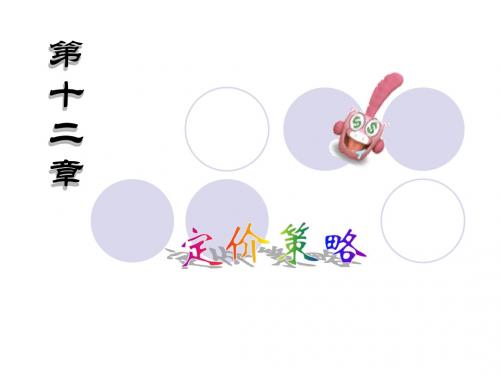
混合联合捆绑
2018/10/3
22
第四节 价格调整及价格变动反应
一、企业降价与提价
降价
产能过剩P扩大销售 竞争压力P保持份额 成本优势P控制市场
2018/10/3
提价
通货膨胀P保证赢利 供不应求P限制需求
23
二、顾客对企业变价的反应
顾客眼中的 降价
式样陈旧
顾客眼中的
提价
数量有限
有缺点 财务困难 还要跌
质量有问题
2018/10/3
有价值 赚大钱 还要涨
24
三、竞争者对企业变价的反应
1.了解竞争者反应的主要途径 2.竞争者反应的主要类型 相向式反应 逆向式反应 交叉式反应
2018/10/3 25
四、企业对竞争者变价的反应
1.不同市场环境下的企业反应
影响因素
内部因素
一、定价目标 二、产品成本
外部因素
三、市场需求 四、竞争者的产 品和价格 五、政府的政策 法令
2018/10/3
4
内部因素
一、定价目标
维持生存
指企业通过特定水平的
价格制定或调整所要达 到的预期目的
当期利润最大化
市场占有率最大化 产品质量最优化
2018/10/3
5
内部因素
下降2% 推出鼓励再次 购买的折价券 2018/10/3
下降2%-4% 降价幅度为 竞争者的一半
下降超过4% 降低到 竞争者的水平 27
2.市场主导者的反应
维持价格不变
降价
提价
2018/10/3
28
3.企业应变需考虑的因素
(1) 产品生命周期所处的阶段及其在企业产品投资组合 中的重要程度 (2) 竞争者的意图和资源 (3) 市场对价格和价值的敏感性 (4) 成本费用随着产销量的变化而变化的情况
- 1、下载文档前请自行甄别文档内容的完整性,平台不提供额外的编辑、内容补充、找答案等附加服务。
- 2、"仅部分预览"的文档,不可在线预览部分如存在完整性等问题,可反馈申请退款(可完整预览的文档不适用该条件!)。
- 3、如文档侵犯您的权益,请联系客服反馈,我们会尽快为您处理(人工客服工作时间:9:00-18:30)。
高价格
顾客评估 产品特点
在此价 格上没 有需求
竞争价格 和代用品 价格
成本
低价格
在此价格上 不可能获利
l
营销理论认为:
产品的最高价格取决于产品的市场需求; 产品的最低价格取决于产品的成本; 在最高价格与最低价格的幅度内,企业 对产品的定价,取决于竞争者同类产品 的价格。
l l l
l
l
Pricing Methods
l l l l l l
Markup Pricing Target Return Pricing Perceived Value Pricing Value Pricing Going-Rate Pricing Sealed-Bid Pricing
第二节 定价方法
l
l
l l
一、成本定价法 成本定价法是以成本为基础,加上一定的利润来制定 价格。企业处在不同的市场营销环境中,需要补偿的成 本有所不同,因而选择不同的成本,就形成了不同的成 本定价方法。 1.成本加成定价法Markup Pricing The most elementary pricing method is to add a standard markup to products cost.
l
l
l
How should a price be set on a product for the first time? how should the price be adapted to meet varying circumstances and opportunities? When should the company initiate a price change and how should it respond to a competitor’s price change?
l
l l
2.盈亏平衡 定价法 Break-even volume=fixed cost/(price-variable cost)
金 额
16 14 12 10 8
总收入
总成本
6
4 2
固定成本
0
20
40
60
80
100
120
销售量
l
l l l
l
P=F/Q+V 式中:P~产品的价格 F~固定成本 Q~销量 V~单位变动成本 例:某企业2001年计划生产油漆2000吨,其固定 成本40万元,单位变动成本为1000元,在保证全 部销售的条件下,其盈亏平衡价格是: 400000/2000+1000=1200元/吨 平衡点的价格仅能使企业的生产成本得以补 偿,没有盈利。
入增加,涨价则会使总收入减少;if demand is
elastic ,sellers will consider lowering the price.a lower price will produce more total revenue.
如果需求是单元弹性的,价格变化对总收 入就没有影响。
Types of Costs
• 如果企业提供的东西与一个主要竞争者提供的相似,那企业 必须把价格定的接近与竞争者,否则就要失去销售额。 • 若企业提供的东西是次级的,企业就不能够象竞争者所做的那 样定价。 • 若企业提供的东西是优越的,企业的索价就可比竞争者高。
The Three C’s Model for Price Setting
价格弹性
影响价格弹性的因素
一般说,影响需求的价格弹性的因素有三个:
时间的长短time
substitutes or competitors 商品的需要程度 degrees of damand
是否有替代品
价格弹性和决策 如果当前的价格处于非弹性需求,降价就会 导致总收入的减少,涨价反而使总收入增加; 如果具有弹性需求的产品减价,则会使总收
method
6. Selecting final price
制定产品价格的六个步骤
分析竞者 的成本 价格和 提供物
选择 定价 目标
确定 需求
估计 成本
选择 定价 方法
选定 最终 价格
选择定价目标
l
l
l
l
l
追求盈利最大化maximum current profit较长时间企业的目标 最大市场撇脂market skimming (英特尔公 司计算机集成电路,1000-500 最大市场份额market share (格兰士) 产品质量领导者product quality leader 生存survival
图 2 无弹性和有弹性的需求
二、确定需求水平
l
l
l
The first involves statistically analyzing past prices,quantities sold ,and other factors to estimate their relationships. The second approach is to conduct price experiments. The third approach is to ask buyers to state how many units they would buy at different proposed prices.
卖方可运用各种营销策略和手段,影响顾客对产品的 认识,使之形成对卖方有利的价值观念,再根 据产品在顾客心目中的价值定价。
l l l
l
例:美国卡特彼拉公司销售某种拖拉机,成功
运用了理解价值定价方法,虽然其价格比同类 产品高4000美元,市场销量依然很大。 销售经理对产品价高的解释是:
t
NOW ASSUME the manufacturer wants to earn a 20 percent markup on sales, l Markup price= unit cos l (1-desired return on sales) =16/(1-0.2)=20
l
l
优点:
l
第十二章 价格策略
l
l
在营销组合策略中,价格是唯一能产 生收入的因素 科学而艺术的定价是产品成功进入市 场的重要因素之一
Objectives
l l
l
Setting the Price Adapting the Price Initiating & Responding to Price Changes
Fixed Costs (Overhead) Costs that don’t vary with sales or production levels. Executive Salaries Rent
Variable Costs Costs that do vary directly with the level of production. Raw materials
二、确定需求水平
Price elasticity of demand
Marketers should know how responsive, elastic demand would be to a change in price
图示
需求数量变动的% 需求的价格弹性 = 价格变动的% 就威望商品来说,需求虚线有时是呈正斜率的。
二、确定需求水平
公司可能收取的每一种价格都将导致一个不同水 平的需求以及由此对它的营销目标产生不同的 效果。在正常情况下,需求和价格是反向关系, 也就是说,价格越高,需求越低(或反之亦 然)。Each price will lead to a different
level of damand and therefore have a different impact on a companys marketing objectives. The relation between alternative prices and the resulting current demand is captured in a demand curve.
Total Costs Sum of the Fixed and Variable Costs for a Given Level of Production
三、估算成本
成本的类型:一个公司的成本有两种形式 ——固定成本和变动成本
固定成本:是不随生产或销售收入的变化而变化的成本。 固定成本的发生是与生产水平无关的。
l
l
l
l l l
Suppose a toaster has the following costs and sales expectations: variable cost per unit 10 Fixed cost 300000 Expected unit sales 50000 The cars unit cost is given by ; Unit cost =variable cost +fixed cost/unit sales =10+300000/5000=16
Setting Pricing Policy
1.
Selecting the pricing objective
2. Determining demand
3. Estimating costs
4. Analyzing competitors’
costs, prices, and offers
5. Selecting a pricing
l
l
适用:销售比较困难,市场竞需求定价法
l
l l l l l
需求定价法是以顾客对产品价值的感受和需 求强度来定价,不是依据卖方成本来制定价格 1.理解价值定价法perceived-value pricing 理解价值(认知价值,感知价值) 是指根据 顾客对产品价值的理解度,即顾客在观念上所 理解的价值,而不是产品的实际价值。
